Blunt’s work was the
culmination of more than thirty years of a very deep interest, both in the artist himself
and in the thinking about art during his lifetime. You can read Blunt’s book online …
https://archive.org/details/nicolaspoussin0000anth/page/n7/mode/2up
If I may be blunt, Poussin
idealized mythical figures in imagined settings, as did most painters. I
guess he was popular for his spacious and GRACIOUS and somewhat understated
theatricality … and for the beauty and elegance of his figures in his warm
idealized spaces. His arcadian conception
of the vast dreamy mythical landscape was delightful. Also, he was valued for his subtle
re-interpretation of so many written narratives. His paintings, both the mythical and the
religious, offer a key to many deep and meaningful conversations about
classical culture and philosophy.
“Spencer Alley” ’s eighteen
invaluable condensed posts are as follows …
https://spenceralley.blogspot.com/2021/02/anthony-blunt-on-nicolas-poussin-three.html
https://spenceralley.blogspot.com/2021/02/anthony-blunt-on-nicolas-poussin_16.html
https://spenceralley.blogspot.com/2021/02/anthony-blunt-on-nicolas-poussin_17.html
https://spenceralley.blogspot.com/2021/02/anthony-blunt-on-nicolas-poussin_18.html
https://spenceralley.blogspot.com/2021/02/anthony-blunt-on-nicolas-poussin_19.html
https://spenceralley.blogspot.com/2021/02/anthony-blunt-on-nicolas-poussin_20.html
https://spenceralley.blogspot.com/2021/02/anthony-blunt-on-nicolas-poussin_21.html
https://spenceralley.blogspot.com/2021/02/anthony-blunt-on-nicolas-poussin_22.html
https://spenceralley.blogspot.com/2021/02/anthony-blunt-on-nicolas-poussin_23.html
https://spenceralley.blogspot.com/2021/02/anthony-blunt-on-nicolas-poussin-old_24.html
https://spenceralley.blogspot.com/2021/02/anthony-blunt-on-nicolas-poussin-old.html
https://spenceralley.blogspot.com/2021/02/anthony-blunt-on-nicolas-poussin-four.html
https://spenceralley.blogspot.com/2021/02/anthony-blunt-on-nicolas-poussin_27.html
https://spenceralley.blogspot.com/2021/02/anthony-blunt-on-nicolas-poussin.html
https://spenceralley.blogspot.com/2021/03/anthony-blunt-on-nicolas-poussin_1.html
https://spenceralley.blogspot.com/2021/03/anthony-blunt-on-nicolas-poussin_2.html
https://spenceralley.blogspot.com/2021/03/anthony-blunt-on-nicolas-poussin_3.html
https://spenceralley.blogspot.com/2021/03/anthony-blunt-on-nicolas-poussin_4.html
“Spencer Alley” even
includes a long section about wrong attributions, copies, forgeries, etc.
https://spenceralley.blogspot.com/2021/03/anthony-blunt-on-nicolas-poussin.html
Three of the “stand-out”
pictures among the many are …
ONE
Landscape with Orion
HISTORY: Painted for
[Michel] Passart. Pierre de Beauchamp, Maître des Ballets du Roi,
by 1687. Andrew Hay sale, London, 1745, bought Duke of Rutland; Duke of Rutland
sale, London, 1758, bought Joshua Reynolds; Calonne sale, Skinner and Dyke,
London, 1795, as from the Reynolds collection, bought Bryan (i.e. bought by
Calonne's mortgagees); Bryan pictures for sale by private treaty, 1795;
Desenfans; sale of pictures bought by him for the King of Poland, Skinner and
Dyke, London, 1802; Philip Panné sale, Christie, London, 1819, bought
Bonnemaison; probably sold by him to the Rev. John Sanford, who lent it to the
British Institution in 1821; bequeathed to his son-in-law, Lord Methuen; sold
by his son in or shortly before 1924; bought by Durlacher, London, in 1924;
bought by the Metropolitan Museum the same year.
"The immediate
classical source for the composition is a description of a painting in Lucian:
"Orion, who is blind, is carrying Cedalion, and the latter, riding on his
back, is showing him the way to the sunlight. The rising sun is healing
the blindness of Orion, and Hephaestus views the incident from
Lemnos." As Professor [E.H.] Gombrich points out, Poussin's
rendering of the subject differs from this in one important respect: Hephaestus
does not view the scene from Lemnos but stands beside Orion, pointing out to
the guide the way to the rising sun, and instead it is Diana who surveys the
scene, though standing on a cloud and not on the island. It was no doubt
her prominence in the composition that misled [André] Félibien into describing
the picture as a landscape "with Orion blinded by Diana," in spite of
the fact that no classical authority attributes his blindness to the
goddess. Further, no classical source would explain the cloud on which
the goddess stands and which rises almost from the ground near the trees behind
the giant. Professor Gombrich has pointed out that all the details of Poussin's
version are explicable if we suppose that he based it on the account of Orion
given by the sixteenth-century writer on mythology, Natalis Comes (Natale
Conti). Comes bases his story on the obscure and curious version given by
Euphorion, who attributes to the giant a triple paternity, the fathers being
Neptune, Jupiter, and Apollo. Since these three gods represent water,
air, and sun respectively, Comes turns the story of Orion's birth into an allegory
for the creation of clouds and rain, which are compounded of these three
elements. . . . Strange though this allegorization of the story is,
it accounts for all the details in Poussin's composition which are not in
accordance with classical sources."
TWO
Landscape with Polyphemus
HISTORY: Painted in 1649 for
[Jean] Pointel. Bought by [Denis] Diderot, with the Landscape with
Hercules and Cacus, from the collection of the Marquis do Conflans in 1772
for the Empress Catherine II of Russia.
"Here [in the Landscape
with Polyphemus] the theme is evidently a moment in the early history of
man, when he had just discovered the arts of agriculture. In the middle
distance we see men digging, plowing, and watching their flocks; in the foreground
are three water nymphs, the symbols of the fertility that water brings to the
land, one of whom, to underline her function, has hair of a blue-green color.
Behind the bushes are hidden peeping satyrs, another traditional symbol of
fertility, though in the animal rather than in the vegetable kingdom. On
the top of a mountain in the background is seated Polyphemus, playing on his
pipes to an invisible Galatea, who is no doubt disporting herself in the sea,
which is just visible in the extreme distance on the right. In classical
mythology the Cyclopes stand for the Golden Age before the invention of
agriculture, when man lived off the fruits of the earth, and Polyphemus
therefore symbolizes the age that is disappearing before the advance of man."
THREE
Landscape with Hercules
and Cacus
HISTORY: Bought by [Denis]
Diderot (together with the Landscape with Polyphemus) in 1772 from
the Marquis de Conflans for the Empress Catherine II of Russia. Sent to Moscow
from the Hermitage in 1930.
"The remaining
landscape of this group, the Hercules and Cacus, belongs
iconographically to a slightly different type. It illustrates the defeat
of the giant as told by Evander in the eighth book of the Aeneid.
According to this version of the story Cacus lived in a cave on the side of the
Aventine. Poussin's landscape bears no relation to the actual Aventine,
but it follow very closely Virgil's description of the scene: "Now first
look at this rocky overhanging cliff, how the masses are scattered afar, how the
mountain-dwelling stands desolate, and the crags have toppled down in might
ruin! Here was once a cave, receding to unfathomed depth, never visited
by the sun's rays, where dwelt the awful shape of half-human Cacus; and ever
the ground reeked with fresh blood." Then follows the story of the
theft of the cattle, its detection by Hercules, and his attack on the giant,
who had taken refuge in his cave. . . . Virgil then describes how
Hercules throttles the giant, and finally, "the shapeless carcass is dragged
forth by the feet." Except for the fact that he shows Cacus as
completely human in form, Poussin follows this description with great
exactness. . . . The victory of Hercules over Cacus had been for
centuries a regular symbol of the destruction of the forces of evil, and that
is no doubt its principal significance for Poussin. By using Virgil's
text and locating the scene in the Aventine, Poussin is linking the story with
the early history of Rome and so taking up again the theme of early Roman legends
and history which had had treated in the 1630's, for, as Ovid tells us, the Ara
Maxima was set up by Potitius on the site of the hero's victory over
Cacus."
Blunt also comments on a very late painting, unfinished and given away by Poussin whilst his health was failing …
APOLLO AND DAPHNE
HISTORY: Given to Cardinal
Camillo Massimi by Poussin in 1664, because the artist realized that he could
no longer work and would therefore not be able to finish it; apparently sold
with [Cardinal Massimi's] palace to Cardinal Nerli, since a picture by Poussin
described as "un Apollo, che perseguita Dafne" appears in
Rossi's Descrizione di Roma moderna of 1697, written when the
palace belonged to the Cardinal. The picture is not mentioned in the edition of
1727, by which time the palace had been bought by Cardinal Alessandro Albani,
but it reappears in Martinelli's Roma ricerata of 1750 and and
in Roisecco's Roma ampliata e rinnovata of 1762; it is still
mentioned in Melchiorri's Guida metodica di Roma of 1840, but
the author was probably copying earlier guides without checking, since the
picture was apparently by that time in France. Erard sale, Henry, Paris, 1832;
Marquis de Gouvello; bought by the Louvre in 1869.
"The Apollo and
Daphne is [Poussin's] swan song in mythology – literally, because he
gave it unfinished to Cardinal Massimi within a year of his death. The
picture is in every respect different from the paintings and drawings which
Poussin had made around the story in his early years, and stands out even more
among his late works by its stillness and remoteness, by the strange tensions
between the figures, and by the intensely poetical atmosphere of the whole
composition. . . . Poussin has followed Ovid closely in many
details. According to his version, Apollo, having just slain the serpent
Python with his arrows, meets Cupid, who is polishing his bow, and mocks him
for daring to use such a weapon, which, he asserts, is not for children but
only for gods like himself to slay creatures like Python. Apollo flies
off, but Cupid follows and shoots at him one of his sharp golden arrows,
thereby inflaming him with love for Daphne, while at the same time he shoots at
her a blunt, lead-tipped arrow, which prevents her from ever returning his
love. Daphne then takes to the woods and becomes a huntress like Diana,
and when her father, the river Peneus, proposes that she marry one of her many
suitors, she begs him to allow her to remain a virgin. The story ends
with the pursuit of Daphne by Apollo, her appeal to Peneus to save her, and her
transformation into a laurel, the theme most usually illustrated in
painting."
"From this story
Poussin selects the stage when Apollo has already been struck by the golden
arrow and Cupid is about to shoot the leaden arrow at Daphne, that is to say, a
moment which emphasizes the opposing effects of the two arrows on the
victims. . . . Like so many of the late works, the Apollo
and Daphne is divided sharply into two parts, but in this case the
opposition of these two parts is also a direct expression of the allegorical
theme. On the left are all the symbols of life and fertility. . .
. On the right is sterility and death. . . . The two opposed
groups are bound together by the most complex network of tensions ever used by
Poussin. Apollo and Melia gaze at Daphne, who keeps her eyes shut as if
to avoid the god's look, while Peneus gazes blindly at the spectator and points
with one hand to the stream below him; Cupid looks and shoots in the direction
of Apollo's gaze, while the two nymphs standing beside Peneus gaze across at
the group on the left; the two nymphs seated at the feet of Apollo turn to look
up at him; and one of those at the feet of the river god, though she looks up
at him, points with one hand across the compositions at the two naiads near
Apollo"




_Detail.jpg)

.png)
.jpg)
.jpg)
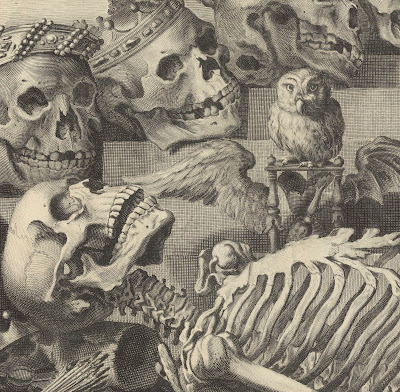

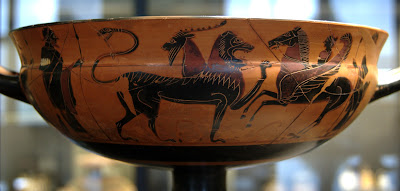







.png)
.tmb-img-1824.jpg)

.jpg)

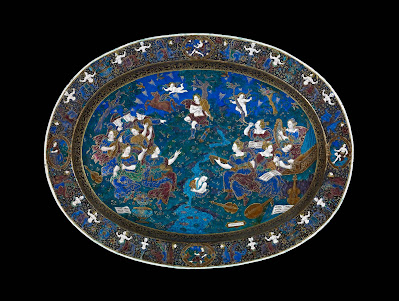

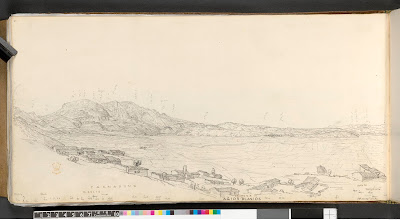






.png)



.jpg)









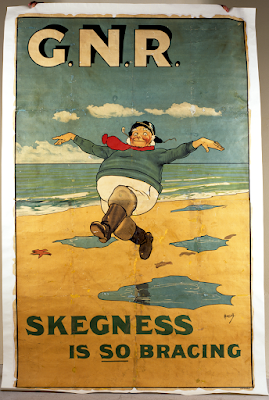
.png)
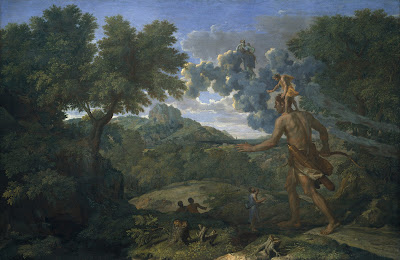
.jpg)
-Landscape-with-Hercules-and-Cacus-c1655-oil-on-canvas-Pushkin-Museum-Moscow.jpg)
-Apollo-and-Daphne-c1664-oil-on-canvas-(unfinished-at-death)-Mus%C3%A9e-du-Louvre.jpg)